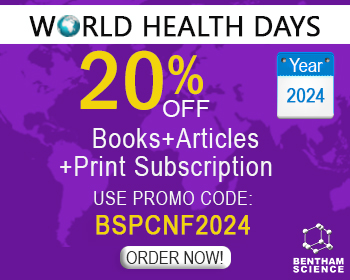Abstract
Tuberculosis (TB) and Malaria are neglected diseases, which continue to be major causes of morbidity and mortality worldwide, killing together around 5 million people each year. Mycolic acids, the hallmark of mycobacteria, are high-molecular-weight - alkyl, β-hydroxy fatty acids. Biochemical and genetic experimental data have shown that the product of the M. tuberculosis inhA structural gene (InhA) is the primary target of isoniazid mode of action, the most prescribed anti-tubercular agent. InhA was identified as an NADH-dependent enoyl-ACP(CoA) reductase specific for long-chain enoyl thioesters and is a member of the Type II fatty acid biosynthesis system, which elongates acyl fatty acid precursors of mycolic acids. M. tuberculosis and P. falciparum enoyl reductases are targets for the development of anti-tubercular and antimalarial agents. Here we present a brief description of the mechanism of action of, and resistance to, isoniazid. In addition, data on inhibition of mycobacterial and plasmodial enoyl reductases by triclosan are presented. We also describe recent efforts to develop inhibitors of M. tuberculosis and P. falciparum enoyl reductase enzyme activity.
Keywords: Tuberculosis, mycobacteria, mycolic acids, isoniazid, InhA, enoyl reductase, drugs
Current Drug Targets
Title: Enoyl Reductases as Targets for the Development of Anti-Tubercular and Anti-Malarial Agents
Volume: 8 Issue: 3
Author(s): J. S. Oliveira, I. B. Vasconcelos, I. S. Moreira, D. S. Santos and L. A. Basso
Affiliation:
Keywords: Tuberculosis, mycobacteria, mycolic acids, isoniazid, InhA, enoyl reductase, drugs
Abstract: Tuberculosis (TB) and Malaria are neglected diseases, which continue to be major causes of morbidity and mortality worldwide, killing together around 5 million people each year. Mycolic acids, the hallmark of mycobacteria, are high-molecular-weight - alkyl, β-hydroxy fatty acids. Biochemical and genetic experimental data have shown that the product of the M. tuberculosis inhA structural gene (InhA) is the primary target of isoniazid mode of action, the most prescribed anti-tubercular agent. InhA was identified as an NADH-dependent enoyl-ACP(CoA) reductase specific for long-chain enoyl thioesters and is a member of the Type II fatty acid biosynthesis system, which elongates acyl fatty acid precursors of mycolic acids. M. tuberculosis and P. falciparum enoyl reductases are targets for the development of anti-tubercular and antimalarial agents. Here we present a brief description of the mechanism of action of, and resistance to, isoniazid. In addition, data on inhibition of mycobacterial and plasmodial enoyl reductases by triclosan are presented. We also describe recent efforts to develop inhibitors of M. tuberculosis and P. falciparum enoyl reductase enzyme activity.
Export Options
About this article
Cite this article as:
Oliveira S. J., Vasconcelos B. I., Moreira S. I., Santos S. D. and Basso A. L., Enoyl Reductases as Targets for the Development of Anti-Tubercular and Anti-Malarial Agents, Current Drug Targets 2007; 8 (3) . https://dx.doi.org/10.2174/138945007780058942
| DOI https://dx.doi.org/10.2174/138945007780058942 |
Print ISSN 1389-4501 |
| Publisher Name Bentham Science Publisher |
Online ISSN 1873-5592 |
Call for Papers in Thematic Issues
New drug therapy for eye diseases
Eyesight is one of the most critical senses, accounting for over 80% of our perceptions. Our quality of life might be significantly affected by eye disease, including glaucoma, diabetic retinopathy, dry eye, etc. Although the development of microinvasive ocular surgery reduces surgical complications and improves overall outcomes, medication therapy is ...read more
 19
19
- Author Guidelines
- Graphical Abstracts
- Fabricating and Stating False Information
- Research Misconduct
- Post Publication Discussions and Corrections
- Publishing Ethics and Rectitude
- Increase Visibility of Your Article
- Archiving Policies
- Peer Review Workflow
- Order Your Article Before Print
- Promote Your Article
- Manuscript Transfer Facility
- Editorial Policies
- Allegations from Whistleblowers
Related Articles
-
Comprehensive Evaluation and Clinical Application of Combined Redox Assay Methods to Determine Total Antioxidant Capacity
Current Analytical Chemistry QSAR Models for Anti-Malarial Activity of 4-Aminoquinolines
Current Computer-Aided Drug Design Structural Analysis of Dihydrofolate Reductase and Thymidylate Synthase from Mammalian and Pathogenic Organisms
Current Enzyme Inhibition Biologic Agents for Treatment of Rheumatoid Arthritis
Anti-Inflammatory & Anti-Allergy Agents in Medicinal Chemistry QSAR and Docking Studies on Propenone Derivatives as Dual COX and 5- LOX Inhibitors
Letters in Organic Chemistry Medicinal Research Progress of Natural Coumarin and its Derivatives
The Natural Products Journal Toxicities of Immunosuppressive Treatment of Autoimmune Neurologic Diseases
Current Neuropharmacology Surfactant Protein A - From Genes to Human Lung Diseases
Current Medicinal Chemistry Insights in Nanoparticle-Bacterium Interactions: New Frontiers to Bypass Bacterial Resistance to Antibiotics
Current Pharmaceutical Design Perspectives and Prospects on mRNA Vaccine Development for COVID-19
Current Medicinal Chemistry Effect of Pistacia atlantica on the Elimination of Helicobacter pylori and Improvement of Gastric Reflux in Patients with Chronic Cough: A Randomized Clinical Trial
Current Traditional Medicine 4-Mer Hyaluronan Oligosaccharides Stimulate Inflammation Response in Synovial Fibroblasts in Part via TAK-1 and in Part via p38-MAPK
Current Medicinal Chemistry Tuberculosis Drug Targets
Current Drug Targets Nitroimidazoles, Quinolones and Oxazolidinones as Fluorine Bearing Antitubercular Clinical Candidates
Mini-Reviews in Medicinal Chemistry A Comprehensive Review of the Genus Pyrola Herbs in Traditional Uses, Phytochemistry and Pharmacological Activities
Current Topics in Medicinal Chemistry Role of Lipopolysaccharides in Potential Applications of Nanocarrier Systems
Current Pharmaceutical Design Potential Strategies for Minimizing Mechanism-Based Inhibition of Cytochrome P450 3A4
Current Pharmaceutical Design Preface
Current Drug Targets - Infectious Disorders The Central Role of Angiotensin I-Converting Enzyme in Vertebrate Pathophysiology
Current Topics in Medicinal Chemistry A Review on Nuclear Imaging as a Promising Modality for Efficient Diagnosis of Tuberculosis
Current Medical Imaging























